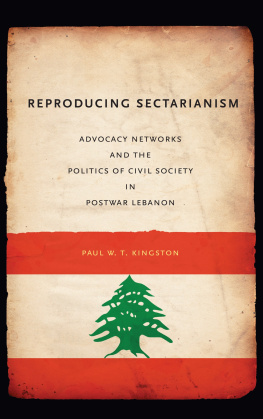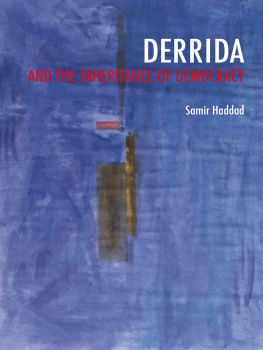Haddad Fanar - Understanding Sectarianism
Here you can read online Haddad Fanar - Understanding Sectarianism full text of the book (entire story) in english for free. Download pdf and epub, get meaning, cover and reviews about this ebook. year: 2019, publisher: Oxford University Press, Incorporated, genre: Politics. Description of the work, (preface) as well as reviews are available. Best literature library LitArk.com created for fans of good reading and offers a wide selection of genres:
Romance novel
Science fiction
Adventure
Detective
Science
History
Home and family
Prose
Art
Politics
Computer
Non-fiction
Religion
Business
Children
Humor
Choose a favorite category and find really read worthwhile books. Enjoy immersion in the world of imagination, feel the emotions of the characters or learn something new for yourself, make an fascinating discovery.
- Book:Understanding Sectarianism
- Author:
- Publisher:Oxford University Press, Incorporated
- Genre:
- Year:2019
- Rating:4 / 5
- Favourites:Add to favourites
- Your mark:
- 80
- 1
- 2
- 3
- 4
- 5
Understanding Sectarianism: summary, description and annotation
We offer to read an annotation, description, summary or preface (depends on what the author of the book "Understanding Sectarianism" wrote himself). If you haven't found the necessary information about the book — write in the comments, we will try to find it.
Understanding Sectarianism — read online for free the complete book (whole text) full work
Below is the text of the book, divided by pages. System saving the place of the last page read, allows you to conveniently read the book "Understanding Sectarianism" online for free, without having to search again every time where you left off. Put a bookmark, and you can go to the page where you finished reading at any time.
Font size:
Interval:
Bookmark:



Oxford University Press is a department of the University of Oxford. It furthers the Universitys objective of excellence in research, scholarship, and education by publishing worldwide. Oxford is a registered trade mark of Oxford University Press in the UK and certain other countries.
Published in the United States of America by Oxford University Press 198 Madison Avenue, New York, NY 10016, United States of America.
Fanar Haddad, 2020
All rights reserved. No part of this publication may be reproduced, stored in a retrieval system, or transmitted, in any form or by any means, without the prior permission in writing of Oxford University Press, or as expressly permitted by law, by license, or under terms agreed with the appropriate reproduction rights organization. Inquiries concerning reproduction outside the scope of the above should be sent to the Rights Department, Oxford University Press, at the address above.
You must not circulate this work in any other form and you must impose this same condition on any acquirer.
Library of Congress Cataloging-in-Publication Data
ISBN 9780197510629 (print)
ISBN 9780197536049 (updf)
ISBN 9780197536100 (epub)
Names: Fanar Haddad
Title: Understanding 'Sectarianism'
There is no clear starting point to when the idea for this book or the thinking behind it first emerged. Rather, it is the product of over a decades worth of work spent on the subject. As such, it has benefited from the insights, comments, thoughts and suggestions of a number of friends and scholars over the course of many years. Be it through academic symposia or casual conversation, I am thankful for all that I have learnt from them.
My thanks to the members of Aarhus Universitys Sectarianism in the Wake of the Arab Revolts Project Morten Valbjorn, Ray Hinnebusch, Martin Reixinger and Thomas Fibiger for allowing me to share my research and exchange ideas with students and faculty at Aarhus. I would also like to thank Ali Allawi, Madawi al-Rasheed, Keiko Sakai, Zoltan Pall, Eskandar Sadeghi-Boroujerdi, Ahab Bdaiwi, Farid al-Attas and Sajjad Rizvi for lending an analytical ear and indulging my interest in this subject this book would have been a very different and undoubtedly inferior one without their ideas and input. My gratitude and appreciation as well to Wayne Yeo for his research assistance and feedback. Special thanks also to the late Professor Peter Sluglett a gentleman and a scholar but above all a dearly missed colleague who always welcomed my intrusive requests for feedback and discussion during our time working together at the Middle East Institute, National University of Singapore, from 2012 until his unfortunate passing in 2017.
I am especially grateful to Nader Hashemi, Morten Valbjorn, Ray Hinnebusch and Simon Mabon for being so generous with their time and providing such extensive, thoughtful and constructively critical feedback on various chapters of this book. Likewise, special thanks to Toby Dodge for his much-appreciated support, guidance, advice and encouragement over the years. I am especially indebted to him for his help and input on , an earlier version of which was presented in 2018 at a workshop he organized at the London School of Economics on the comparative politics of sub-state identities. In that regard I also owe thanks to Charles Tripp and John Hutchinson for their feedback on the draft submitted to that workshop.
Spouses are always deserving of special mention in authors acknowledgements given how inordinately taxed their capacity for love, generosity, indulgence and kindness becomes when their other halves are immersed in the maddening obsession that is a book project. They go through the pain of reading sub-standard ur-drafts too poor to be shared with colleagues. They have to tolerate sudden absences whenever the writer-partner suspects that an irregularly timed visit from the muses may be upon them. They endure having to endlessly listen to, discuss and bounce ideas about their partners pet subject for longer and more repeatedly than they would do with their own. They have to allay the writer-partners repetitive bouts of self-doubt. But above all, they have to suffer listening to the writer-partner incessantly talk about their bloody book! For all of that and so much more, I am forever grateful to Farah, who not only had to put up with all of the above but did so with more love, encouragement, patience and support than anyone deserves and all while carrying and giving birth to our Mizna. To Farah and Mizna: I love you both.
Is there any call for yet another book on sectarianism? After all, over the past two decades or so, few subfields of Middle Eastern studies or Islamic studies have attracted more scholarly, and some not so scholarly, attention than sectarianism, particularly in relation to the SunniShia divide. Anyone with a sustained interest in the subject cannot but notice the enormous growth not just quantitatively but thankfully in qualitative terms as well of the literature; so why burden the bookshelves with another volume on a subject that has attracted no end of analysis, column inches and, in some cases, outright hot air? To begin with, while this book is about sectarian identity (specifically and exclusively SunniShia identities) this is not a book about sectarianism: in fact one of the primary and more ambitious pie in the sky, some might say purposes of this book is to finally liberate the study of sectarian identity and sectarian relations from the cognitive shackles of the term sectarianism; a term so opaque, circuitous, negatively charged, politically controversial and emotive as to be meaningless (hence the quote marks). As will be discussed in the opening chapter, my objection to the term sectarianism should not be taken to mean a rejection of the study of sectarian identities, sectarian relations or any other sect-coded process or phenomenon; rather, in rejecting sectarianism I am proposing the abandonment of an absurdly catch-all phrase that encompasses so much as to stand in To that end, this book attempts to formulate a theoretical framework that might enable us to cut the conceptual umbilical cord that is sectarianism and to start exploring the innumerable phenomena that the term encompasses and how these relate to each other.
The many ways in which sectarianism is framed, used and understood and the bewildering array of things that it is used to refer to from innocuous sectarian insularity all the way to sectarian murder will be covered in . For now, it suffices to point out that, however the term is used and however it is understood, sectarianism is necessarily a function of, or is related to, sectarian identity. Yet despite that, surveying the literature, one notices a surprising lack of attention given to sectarian identities. Rather, their meaning, contours, inner dynamics and so forth are assumed and then obscured by the analytical black hole that is sectarianism. In other words, the ism has overshadowed the root, creating a ripple effect of confusion as to the parameters, content and drivers of sectarian dynamics. A central contention of this book, therefore, is that we firstly need to discard the cumbersome and entirely unnecessary frame of sectarianism and, secondly, that we should instead direct our analytic focus towards understanding sectarian
Font size:
Interval:
Bookmark:
Similar books «Understanding Sectarianism»
Look at similar books to Understanding Sectarianism. We have selected literature similar in name and meaning in the hope of providing readers with more options to find new, interesting, not yet read works.
Discussion, reviews of the book Understanding Sectarianism and just readers' own opinions. Leave your comments, write what you think about the work, its meaning or the main characters. Specify what exactly you liked and what you didn't like, and why you think so.










